Apple Refreshes iPad Pro Lineup: A10X Fusion SoC for 10.5-inch, 12.9-inch Models
by Matt Humrick on June 6, 2017 6:00 PM EST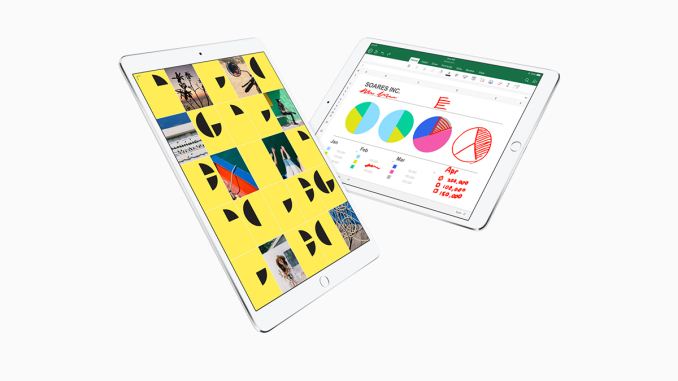
In addition to showing off its latest OS and software updates, Apple made several hardware announcements at WWDC 2017, including a refreshed iPad Pro lineup. The smaller of the two Pros ditches the 9.7-inch screen, which dates all the way back to the original iPad, for a 10.5-inch panel that fits into a chassis only 10.6mm (0.42”) taller and 4.6mm (0.18”) wider than the outgoing model thanks to smaller bezels. The expanded all-aluminum chassis increases weight by 7% or 32 grams, just enough to notice if you’re familiar with one of the recent models. The larger 12.9-inch Pro—first released at the end of 2015—finally gets some attention too. After missing out on the new hardware introduced with the 9.7-inch iPad Pro last year, the big Pro has been brought up to parity with the new 10.5-inch Pro.
Both the 10.5-inch and 12.9-inch LCD panels are new for this generation and share the same specifications. The 264ppi panels can display more vivid and lifelike colors by extending color coverage well beyond the sRGB standard with DCI-P3 gamut support. And because iOS supports ColorSync, Apple’s color management system, the Pros’ wide-gamut panels maintain color accuracy by respecting the source material’s target gamut (no overly-vivid, neon colors when viewing sRGB content, for example).
Both models also support Apple’s True Tone display technology that adjusts the display’s white point based on ambient light. The idea here is for the screen to replicate what happens to a white sheet of paper under different lighting conditions. If you read a printed book in an incandescent bulb’s warm light, the page will reflect that light and appear warmer, more yellow. True Tone does the same thing, reducing the LCD’s blue output and shifting the white point to appear warmer. Matching the display’s output to its environment is supposed to reduce eye strain, but True Tone can be disabled if it’s not to your liking.
Apple claims both displays can hit 600 nits peak brightness, which is impressive for tablets. We previously measured the 9.7-inch iPad Pro at 520 nits and the 12.9-inch iPad Pro at 427 nits, so this should bring a noticeable visibility improvement in bright light, especially for the big Pro. Both panels are also fully laminated to the cover glass and use an improved antireflective coating to further improve visibility and diminish eye strain by reducing screen reflections. The improved coating was first used on the 9.7-inch iPad Pro, and after comparing it side by side with the iPad Air 2, I was really impressed with how well it works.
| Apple iPad Pro Comparison | ||||
| iPad Pro 10.5" (2017) |
iPad Pro 12.9" (2017) |
iPad Pro 9.7" (2016) |
iPad Pro 12.9" (2015) |
|
| SoC | Apple A10X Fusion 3x Apple performance cores 3x Apple efficiency cores 12 core GPU |
Apple A9X 2x Apple Twister @ ~2.2GHz PowerVR 12 Cluster Series7XT |
||
| Display | 10.5-inch 2224x1668 IPS LCD DCI-P3, 120Hz |
12.9-inch 2732x2048 IPS LCD DCI-P3, 120Hz |
9.7-inch 2048x1536 IPS LCD DCI-P3 |
12.9-inch 2732x2048 IPS LCD sRGB |
| Dimensions | 250.6 x 174.1 x 6.1 mm 469 / 477 grams (WiFi / LTE) |
305.7 x 220.6 x 6.9 mm 677 / 692 grams (WiFi / LTE) |
240.0 x 169.5 x 6.1 mm 437 / 444 grams (WiFi / LTE) |
305.7 x 220.6 x 6.9 mm 713 / 723 grams (WiFi / LTE) |
| RAM | ? | 4GB LPDDR4 | 2GB LPDDR4 | 4GB LPDDR4 |
| NAND | All: 64GB / 256GB / 512 GB | All: 32GB / 128GB / 256GB |
WiFi: 32GB / 128GB / 256GB WiFi + Cellular: 128GB / 256GB |
|
| Battery | 30.4 Wh | 41.0 Wh | 27.5 Wh | 38.5 Wh |
| Front Camera | 7MP, f/2.2, Auto HDR, Wide Color Gamut, Retina Flash | 5MP, f/2.2 | 1.2MP, f/2.2 | |
| Rear Camera | 12MP, 1.22µm pixels, f/1.8, PDAF, OIS, Auto HDR, Wide Color Gamut, True Tone Quad-LED flash | 12MP, 1.22µm pixels, f/2.2, True Tone LED flash | 8MP, 1.1µm pixels, f/2.4 | |
| Cellular | 2G / 3G / 4G LTE (Category 9) | 2G / 3G / 4G LTE (Category 4) | ||
| SIM Size | NanoSIM | NanoSIM | ||
| Wireless | 802.11a/b/g/n/ac 2x2 MIMO, BT 4.2 LE, GPS/GLONASS | 802.11a/b/g/n/ac 2x2 MIMO, BT 4.2 LE, GPS/GLONASS | ||
| Connectivity | Apple Lightning, 3.5mm headphone, Apple Smart Connector | Apple Lightning, 3.5mm headphone, Apple Smart Connector | ||
| Launch OS | iOS 10 | iOS 9 | ||
| Launch Price | Wi-Fi: $649 (64GB) $749 (256GB) $949 (512GB) Wi-Fi + LTE: $779 (64GB) $879 (256GB) $1079 (512GB) |
Wi-Fi: $799 (64GB) $899 (256GB) $1099 (512GB) Wi-Fi + LTE: $929 (64GB) $1029 (256GB) $1229 (512GB) |
Wi-Fi: $599 (32GB) $749 (128GB) $899 (256GB) |
Wi-Fi: $799 (32GB) $949 (128GB) $1079 (256GB LTE) |
Before we move on to other hardware, it’s worth mentioning that Apple is using an adaptive refresh rate on the new Pros, a technology it calls ProMotion. The standard refresh rate doubles from 60Hz to 120Hz, which should help UI animations appear more fluid. It also reduces the Apple Pencil’s latency, making inking smoother with less lag. Driving a panel at 120Hz increases power consumption (panel and SoC), however. To help reduce the impact on battery life, the refresh rate is adjusted down to 24Hz or 48Hz when displaying content that would not benefit from the faster refresh, such as reading an ebook or Web page, for example.
Under the display is an Apple A10X Fusion SoC that comes with additional CPU and GPU cores compared to the A10 Fusion SoC used in the iPhone 7. Instead of 2 performance CPU cores and 2 efficiency cores, the A10X Fusion uses 3 of each. It also doubles the number of GPU cores, which makes sense considering it needs to drive a lot more pixels at a higher refresh rate. Apple claims a 30% improvement in CPU performance and a 40% faster GPU compared to the Apple A9X SoC used in the previous generation.
It’s still not clear how much RAM the new Pros have. It’s probably safe to assume that the 12.9-inch model still comes with 4GB, but does the 10.5-inch model stick with 2GB like the 9.7-inch Pro? Considering all of the new multitasking features and visual elements in iOS 10/11, a bump to 4GB is certainly justified, although, Apple tends to be frugal with RAM.
Internal storage capacity doubles, with the least-expensive models packing 64GB of NAND. The next two storage tiers jump to 256GB and 512GB, which makes these iPads a bit more competitive with other ultraportable devices targeted at professionals. The extra space is also essential if you plan to use an iPad for less ‘Pro’ purposes such as watching TV shows or movies, which eat up space quickly.
The cameras on iPads have always seemed like an afterthought, with Apple using iPhone leftovers a generation or two old. Because tablets typically are not the first device people reach for when shooting photos and video, camera hardware is an obvious place to save money. This is not the case with the new iPad Pros, however, which receive the biggest camera upgrade since Apple first added cameras to the iPad 2. Both the front and rear camera modules are shared with the iPhone 7. That means a 7MP FaceTime HD camera on the front that supports automatic HDR imaging, wide color gamut photos, and 1080p video recording. You can also use the iPad’s display as a flash. Around back is a 12MP camera with 1.22µm pixels, OIS, Focus Pixels (PDAF), a 6-element lens array with a large f/1.8 aperture, and a quad-LED True Tone flash. It also supports automatic HDR imaging and wide color gamut photos and uses OIS and EIS for stabilizing video.
The new Pros come with 802.11ac 2x2 MIMO Wi-Fi that offers a peak theoretical throughput of 866Mbps. Like previous iPads, there’s Wi-Fi only and Wi-Fi + LTE cellular variants. The cellular-enabled models get a new Category 9 LTE modem with up to 450Mbps on the downlink. There’s also support for 25 LTE bands and an embedded Apple SIM.
The new iPad Pros look like, well…iPads. The aluminum shell is visually indistinguishable from earlier models and still has a Lightning connector on the bottom, a 3.5mm headphone jack and power button in opposite corners at the top, volume buttons on one side, and an Apple Smart Connector on the other. The proprietary Smart Connector transfers both data and power to optional peripherals such as external keyboards. There are also 4 speakers—2 on the top and 2 on the bottom—that provide better sound than the mono speakers on older iPads and are less prone to being covered by your hands when holding it in landscape mode.
The 12.9-inch Pro looks the same as the previous version from the front, while the 10.5-inch Pro has noticeably narrower bezels along the sides of the display. The physical home button includes an upgraded Touch ID sensor (same as iPhone 7) that’s 2x faster.
Both the 10.5-inch and 12.9-inch iPad Pros are available for preorder and will begin shipping mid June. Unlike the iPhone 7, Apple is not offering any new color choices for the iPads, so we get the familiar Silver, Space Gray, Gold, and Rose Gold. The Apple Pencil can be purchased separately for $99, and Apple offers its Smart Keyboard for $159 and $169 for 10.5- and 12.9-inch models, respectively.


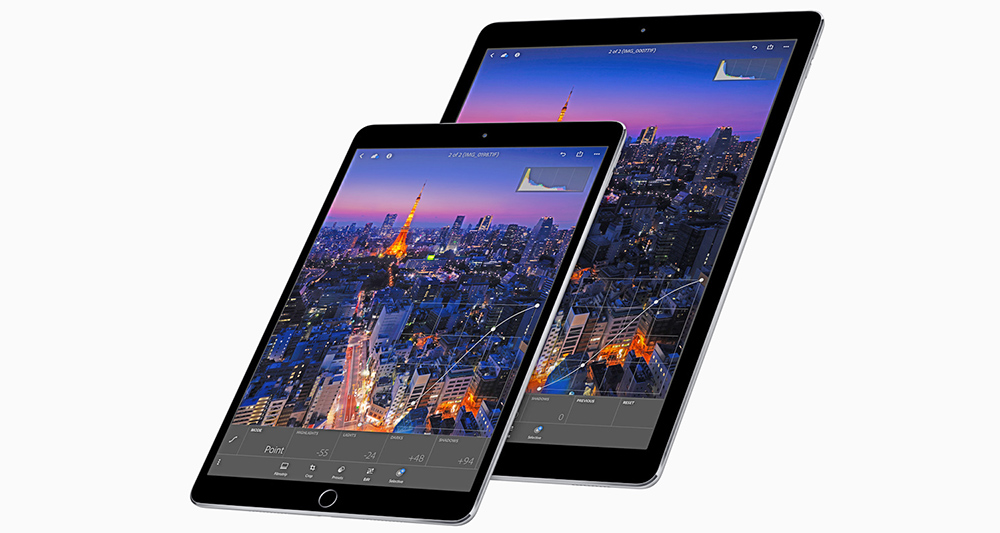
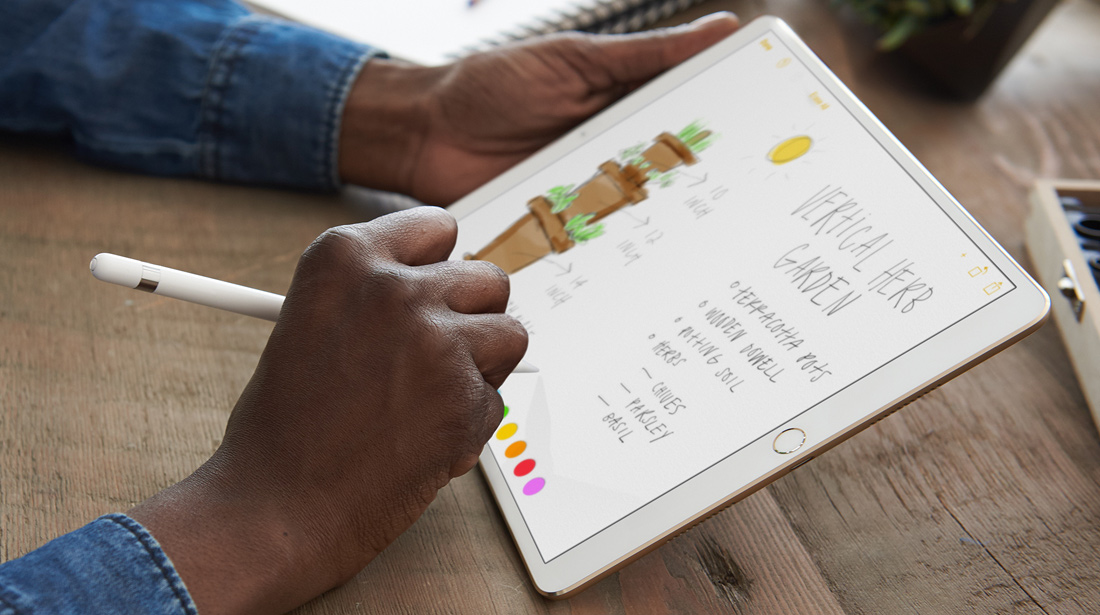
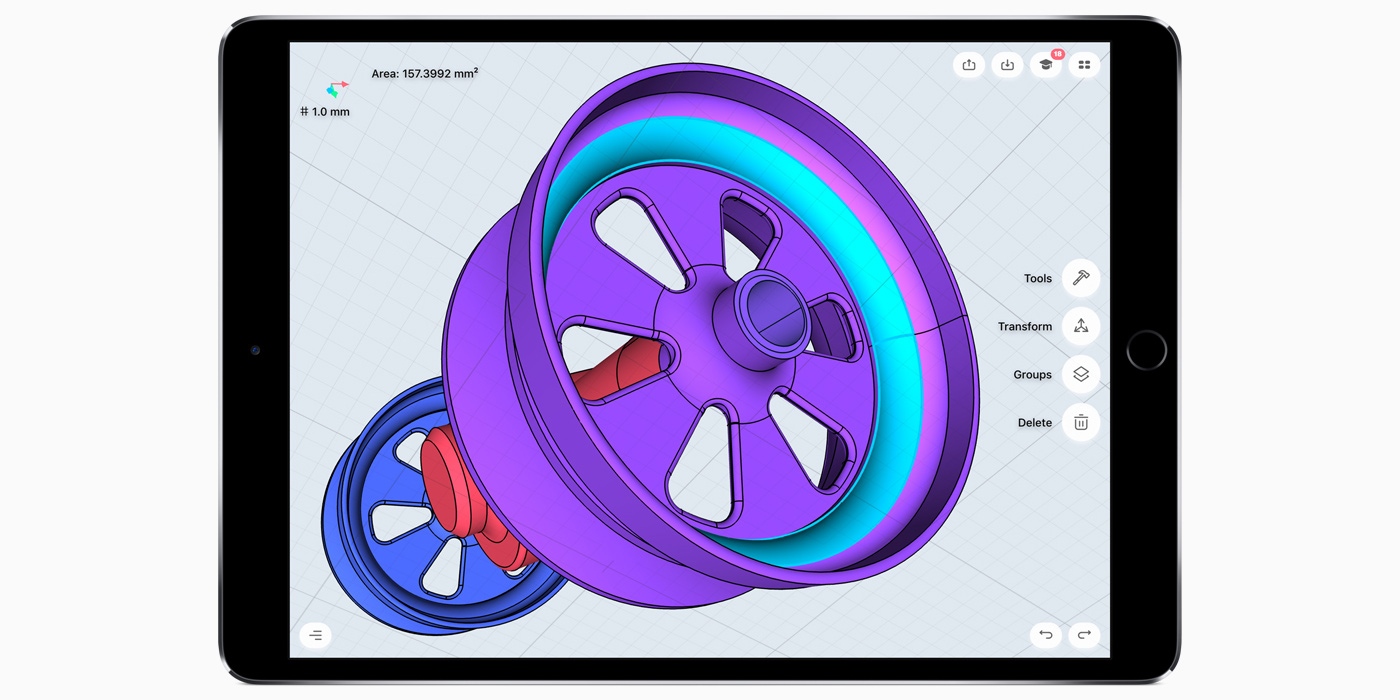
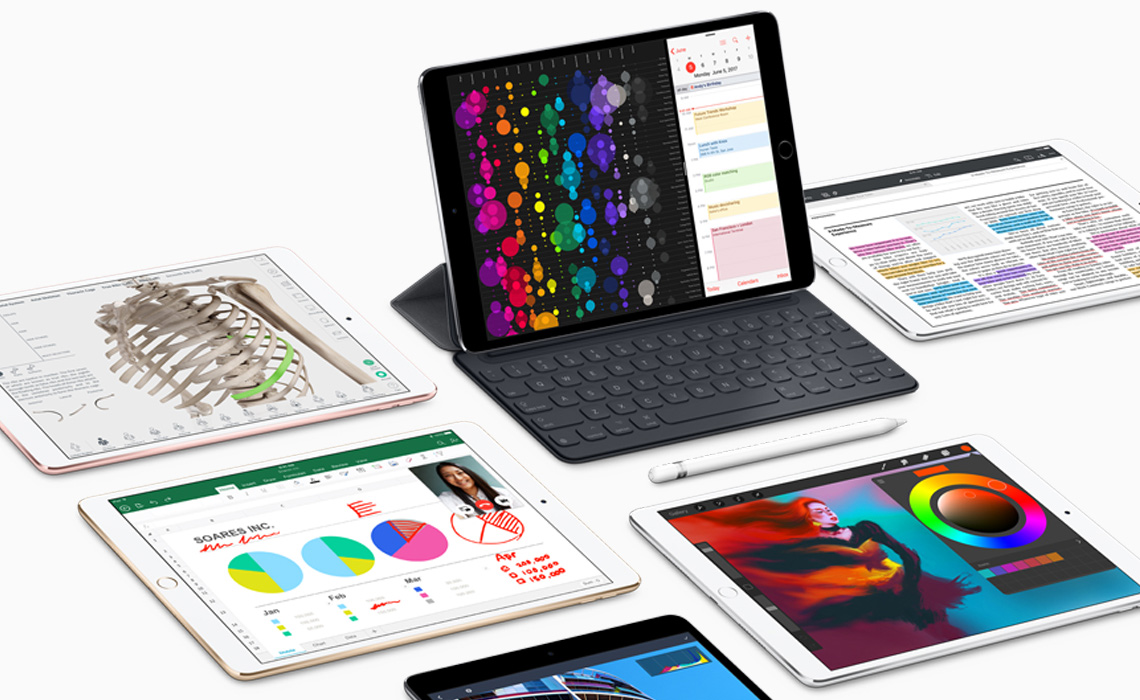








108 Comments
View All Comments
lucam - Thursday, June 8, 2017 - link
Wow! Bloody hell!lefty2 - Wednesday, June 7, 2017 - link
What makes you think it's not 10nm? No one has confirmed if it was 16nm or 10nmname99 - Wednesday, June 7, 2017 - link
The original source of "A10X=10nm" seems to be the (somewhat unreliable) Digitimes.It gained plausibility given the delay in shipping the new iPads, and seemed reasonable ---if Apple were willing to dual-source the A9 to both TSMC and Samsung, maybe they were willing to perform a similar sort of "dual-target-process" trick for TSMC's 16nm and 10nm? It also gained plausibility in that the timelines lined up with when TSMC said 10nm would be ready.
But if you look at the news stories, it was never widely agreed upon, or widely sourced. (Compare to the large-scale agreement by everyone that A11 recently entered manufacturing on TSMC 10nm).
I think the most reasonable interpretation is that we all let our hopes excite us too much! And that the delay in iPad Pros from say October or so till now reflects not a delay to get the A10X on 10nm, but a delay for other reasons. (Perhaps sourcing the screens, which are definitely above average... Perhaps just a deliberate decision by Apple to try to shift what revenue they can from the pile-up quarter of Q4 each year when new iPhones come out into something more evenly spread?)
asendra - Wednesday, June 7, 2017 - link
30% faster single core...with only 5% more clocks. That amazing so I can imagine how you are disappointed?Even so, it also has 1 core more. So it is 82% faster in multi core benchmarks... again, pretty amazing.
http://browser.geekbench.com/v4/cpu/compare/303638...
Meteor2 - Wednesday, June 7, 2017 - link
Thirty percent faster is about in line with what Apple usually does; two years of 40% faster each year gives a doubling of performance which looks nice on keynote slidedecks.Apple does seems to be reaching the same limits Intel and ARM are though -- there's not much room left in the microarchitectures and ISAs for improvement, and production process improvements are now slow and pricey to develop.
name99 - Wednesday, June 7, 2017 - link
There's ZERO evidence for the claim that "Apple does seems to be reaching the same limits Intel and ARM are though" (and to link ARM in the same bracket as Apple and Intel is ludicrous).Apple has maintained a 15% IPC increase through the A7 to A8 to A9 to A10 transitions. Presumably at some point this ends, but there's no evidence so far that we've hit that point.
I could suggest, today, two obvious, feasible improvements that would each buy another 15% for 2018 then 2019. (Use long-term-parking [prediction of which loads and their dependent instructions will miss to RAM, and pro-actively delay them --- this effectively doubles the size of your instruction window without all the hassles that attend other KIP mechanism; then use value prediction and a SMART run-ahead engine to generate excess MLP when your instruction window still fills up).
There are other ideas out there that remain untapped for, for example, reducing energy usage, ranging from the mild improvements (a more sophisticated loop-buffer mechanism that can handle at least one or two branches within a loop) to substantial design rethinks (aggressive, HW-controlled, migration of execution between the low-power and the performance core based on metrics like memory miss-rate and branch misprediction rate).
Hell it's unclear if Apple's so-far even doing the sort of sophisticated frequency boosting based on entire-device (CPUs + GPUs) thermal load that we see in Intel's most recent TurboBoost revisions. (This may be one reason --- just one --- why Apple want to switch to their own GPU...)
What we have seen is that Apple seems to prefer not releasing an innovation in their HW until they're sure it's fully baked. (So we got apparently no interest in low-power companion cores --- until we got a doozy of a release with the A10, which seems vastly more sophisticated and better designed than big.LITTLE. [HW controller doing the switching rather than the OS, much tighter cache sharing like Dynamiq rather than the very expensive separate clusters of traditional big.LITTLE.])
It's possible that when they release their equivalent of TurboBoost it will be the same sort of thing, as fully formed as what Intel offers today, taking into account full device thermal inertia and all heat sources, rather than the various slowly improving iterations that Intel released successively over the past ten years or so.
Meteor2 - Wednesday, June 7, 2017 - link
Mmm, ok, you got me; I was simply going by the annual performance increase dropping from 40% to 30%. Not the most thorough analysis of all time ;).melgross - Wednesday, June 7, 2017 - link
In addition, dropping all support for 32 bits releases some room on the silicon for other uses. We're also seeing Apple come up with new chips (almost every year) for enhanced functionality, which also releases the CPU core from those tasks. While that may not show on tests, it will improve throughput in real world use.Meteor2 - Wednesday, June 7, 2017 - link
Mind you, I care not about IPC nor frequency, only their product: performance. More specifically: performance per Watt.Given that Apple normally announce YoY performance increases of 40% but this is only 30%, my point stands. Apple are finding it harder to increase performance each year, just like ARM, just like Intel.
melgross - Thursday, June 8, 2017 - link
Well, it's likely, that for whatever reason, and I've argued one, that they decided to give up silicon space to 3 cores rather than 2, and so the smaller core increase is due to that, rather than to,any slowing down of Apple's ability to increase per core performance more than they did. We saw the same thing with the A8x. This year, multicore performance increased by over 80%, which is huge. Fewer bigger cores would have resulted in higher performance per core, but a smaller multicore performance increase of perhaps 40%.They may have felt that the increase in multicore was more important this year, possibly because of their new AR push we saw during their WWDC.